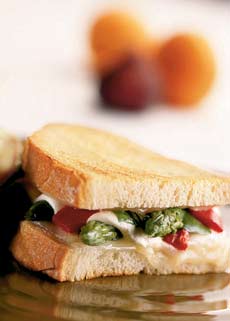
 Gilled rustic Italian bread, grilled vegetables, melted mozzarella: a great grilled cheese sandwich. Photo courtesy of Wisconsin Milk Marketing Board.
Gilled rustic Italian bread, grilled vegetables, melted mozzarella: a great grilled cheese sandwich. Photo courtesy of Wisconsin Milk Marketing Board.
September 2009
Last Updated April 2018
|
 |
Sandwich History
Did The Earl Of Sandwich “Invent” The Sandwich?
CAPSULE REPORT: Before the Earl of Sandwich gave his name to the concept, man certainly put meat and cheese between slices of bread—it was an easy way for field workers and travelers to eat. But it didn’t have a formal name: “bread and cheese” or “lamb in pita” was all the description required. The Earl didn’t even name the sandwich; but merely by being the first in London to specifically order meat served between two slices of bread so that he could eat with one hand while continuing to gamble with the other, he launched the demand for what became known as the sandwich. This is Page 1 of a two-page article. Click on the black links below to visit other pages.
Sandwich History
While the Earl of Sandwich is credited with “inventing” the sandwich in 1762, the principle of bread and filling likely dates to around 9000 B.C.E., when permanent settlements were established in the Middle East, and the hunter-gatherers began to plant and harvest grain. These grains became the first breads, unleavened flatbreads that were baked over an open fire. They were also “edible plates,” holding roasted meat or fish on the journey from pot to mouth.
The first recorded sandwich in history was made by Rabbi Hillel, who lived in Jerusalem in the 1st century B.C.E., at the time of King Herod. Observing the Passover ritual of eating bitter herbs or maror (generally grated horseradish) on matzoh, he placed a sweet filling of chopped apples and nuts, seasoned with cinnamon, alongside the maror, and topped it with a second slice of matzo. The practice, continued today, is known as the Hillel sandwich.
Two millennia later, Becky Mercuri, author of American Sandwich, quotes researcher J. J. Schebel on a French claim that travelers and field workers carried meat between two slices of black bread, long before the “sandwich” gained prominence.
None of this is surprising; in fact, it would be more surprising if slices from loaves of bread had not been used to hold meat, cheese, fish and other fillings. There’s just no notation of it; it took the celebrity of the fourth Earl of Sandwich to give it a name.
John Montagu, Fourth Earl Of Sandwich
While slices of bread with meat and cheese had been eaten since the dawn of the loaf of bread, the term “sandwich” purportedly originated one evening in 1762 at the Beef Steak Club, a private gentleman’s club above Covent Garden in London. John Montagu, the fourth Earl of Sandwich (1718-1792), called for such a dish to be served to him, so he could remain at the gaming table without breaking for supper.
A marathon gambler, necessity was the mother of invention; the sandwich enabled him to keep gaming with one hand while he ate with the other (interestingly, sushi rolls were invented for exactly the same reason). However, the genius wasn’t totally spontaneous: It is said that Montagu was inspired by diplomatic trips to the Mediterranean, where he observed Greeks and Turks eating pita bread stuffed with meats and other fillings.
The practice of serving “sandwiches,” including elaborate presentations of poached fillet of pheasant and guinea hen, soon became a popular late-night meal at society balls. During the nineteenth century, lunch (called midday dinner) was the main meal of the day; dinner (then called supper) was a lighter meal where the leftovers from lunch were often made into sandwiches.
After Victorian author Charlotte Mason wrote the first cookbook recipes for sandwiches—recommending that the crusts be removed from the bread—sandwiches began to be served at tea and picnics. They were common fare at taverns and train stations; the “club sandwich” was developed at a private club.
Coming To America
English traditions easily jumped over the pond. While no one noted the date a sandwich was first served in the U.S., in 1837, Eliza Leslie was the first person to publish a recipe, in Miss Leslie’s Directions For Cookery. One of the sandwiches remains popular today: a ham sandwich with mustard on lightly buttered bread. By the late 1860s, reports Mercuri, sandwiches were common supper fare and travel food.
Continue To Page 2: The Sandwich In America
Go To The Article Index Above
Lifestyle Direct, Inc. All rights reserved. Photographs are the copyright of their respective owners.

|




